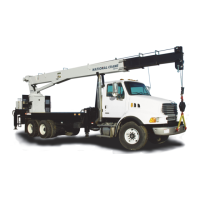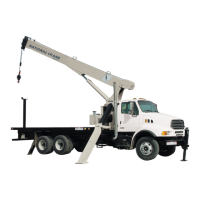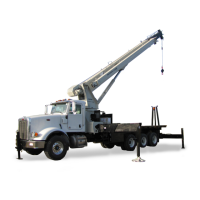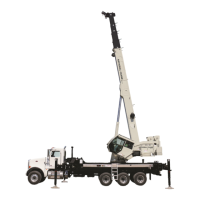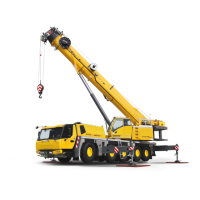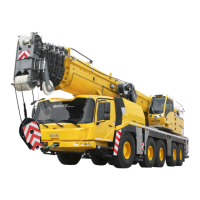2-7
""+
+
The structures and components of your unit are de-
signed to provide satisfactory service if the unit is not
loaded in excess of the maximum rated loads specified
on the load chart. Overloading can create serious po-
tential safety hazards and can also shorten the service
life of your unit. It is important that you know the weight
and radius of any load that you are attempting to handle.
This should be done by use of a dynamometer and tape
measure or by contacting your supervisor.
Overloading a crane
can cause many types of
failure depending on the
configuration and working
position of the crane, i.e.
structural damage to al-
most any part of the crane,
winch or cable failure and
tipping the unit over.
The load chart shows the maximum rated loads in-
cluding load (weight being lifted), load handling equip-
ment such as slings, buckets, and downhaul weights,
etc. which can be handled by the crane and the winch.
The weight of the load handling equipment and boom
attachments must be deducted from the maximum load
rating shown on the load chart to determine the payload
which can be lifted. Additional reduction may be neces-
sary to make allowance for such factors as the effects
of freely swinging loads, wind, ground conditions, out-
of-level conditions and operating speeds.
The ratings shown on the outrigger full span load
chart are maximum loads and are based on the struc-
tural integrity of the crane in shaded areas, the stability
of the crane in nonshaded areas. The stability or non
shaded areas represent a stability tipping factor of 85%
(Note: For New York City approved units the stability or
non shaded areas represent a stability tipping factor of
75%) when:
1. All outriggers are extended with positive contact
on firm, level surface, the tires are free of the
ground and the machine is level within 1°.
2. The proper amount of counterweight has been
installed, if required.
3. The unit is mounted in accordance with factory
instructions on a vehicle with proper specifica-
tions.
4. The weight of load handling devices is consid-
ered as a part of the load being lifted.
5. The correct loadline reeving is used for the load
to be lifted.
6. Adverse environmental conditions such as wind
are not present.
7. The operator controls the loads smoothly.
8. Tires are inflated to the proper pressure.
9. The load to be handled does not exceed the
maximum capacity at the boom length and
loaded radius.
10. The loads are lifted in the proper area around
the truck.
A stability test should have been performed on this
crane and can be repeated by referring to the Installa-
tion Section.
All capacities are given in direct relationship to the
boom length and loaded radius at which the load is be-
ing handled. All radii are measured from the centerline
of rotation to the loadline with the load suspended. All
variances of loads and radii of operation are shown on
the load capacity chart mounted on the main frame.
Boom angle should be used as reference only to aid in
determining radius. The correct loaded radius must be
measured and not exceeded during any point of the lift-
ing operation. The placard is located at the operators
platform for the purpose of informing the operator when
a load can or cannot be handled. Load ratings cannot
be interpolated between load points shown on the chart
in the boom areas. When boom length or radius or both
are between points listed on capacity chart, the small-
est load shown at either the next larger radius or boom
length shall be used. Capacities of the jib cannot be
interpolated between angles nor at reduced lengths
because the strength of the jib and its attachment point
to the boom does not increase when the boom is short-
ened.
"
1. The equipment can be hazardous if improperly
maintained or operated. Read and comply with
the Operator’s Manual supplied with this machine
for information on safety, operation and mainte-
nance before operating this machine. If these
manuals are missing, order replacements from
National Crane through the distributor.
2. Rated loads shown on the capacity chart pertain
to this machine as originally manufactured and
equipped. Modifications to the machine or use
of equipment that is not factory specified or ap-
proved can be hazardous. Refer to capacity de-
duction chart for weights which must be deducted
from rated loads when accessories are attached
to boom or loadline.
$7
1. Inspect vehicle and crane including crane op-
eration prior to use each day.
2. Load ratings shown on the chart are maximum
allowable loads with the crane mounted on a fac-
tory approved truck and all outriggers set on a
firm level surface so the crane is level. This crane
is not rated for use without outriggers.
3. Depending on the nature of the supporting sur-
face, structural supports under the outrigger
floats may be necessary to spread the load to a
larger bearing surface.
4. Always level the crane with the level indicator
located at the operator stations located on ei-
ther side of the crane frame.
,
Q
"
Q
Reference Only
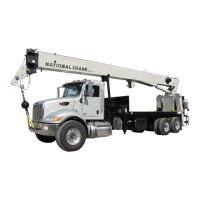
